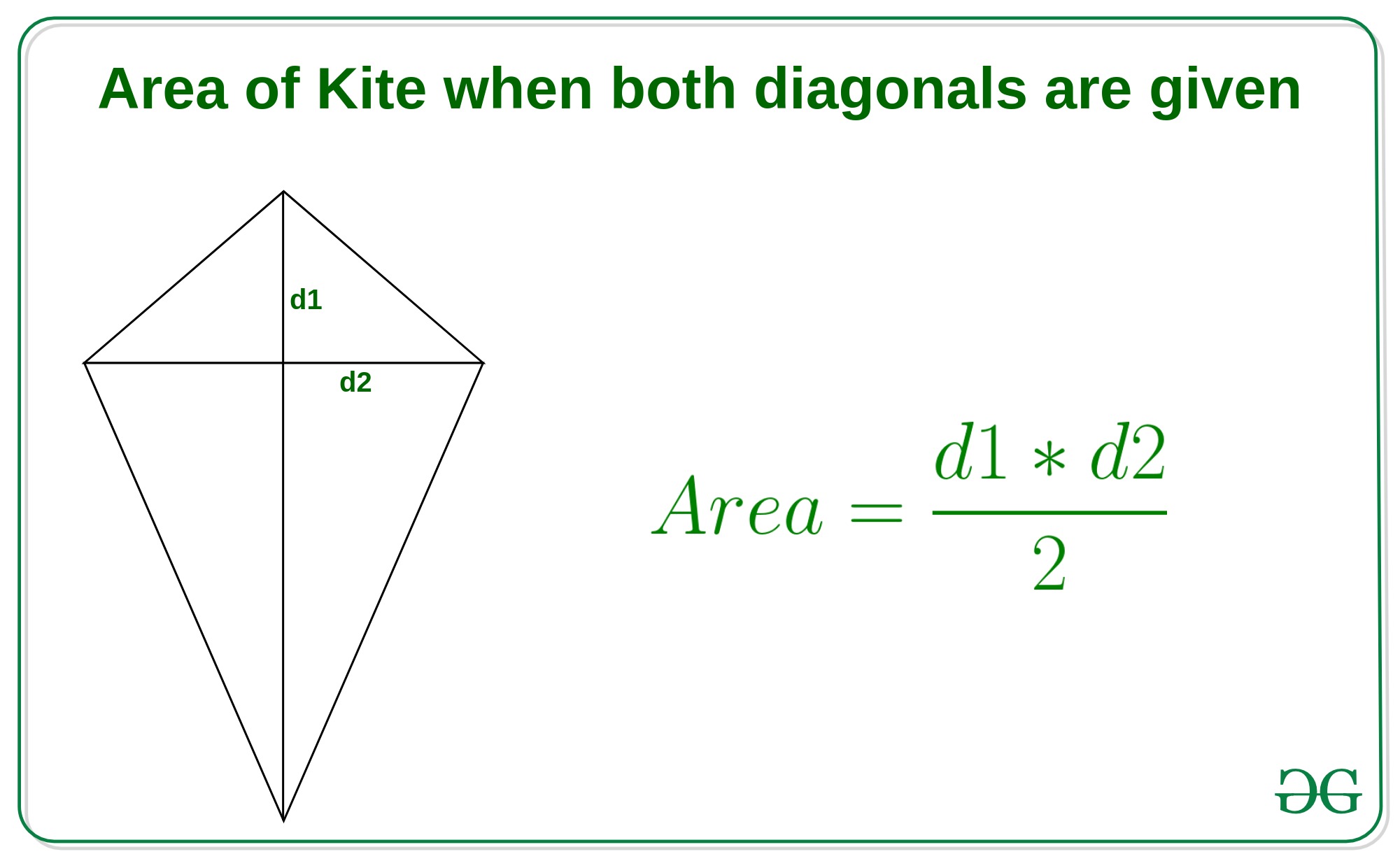Program to calculate the area of Kite
Last Updated :
31 May, 2022
Kite is something like rhombus but in Kite, the adjacent sides are equal and diagonals are generally not equal.
Method 1: When both the diagonals are given

If diagonals d1 and d2 are given of the kite, then the area of a kite is half of product of both the diagonals i.e.
Example:
Input: d1 = 4, d2 = 6
Output: Area of Kite = 12
Input: d1 = 5, d2 = 7
Output: Area of Kite = 17.5
Approach: In this method we simply use above formula.
Below is the implementation of the above approach:
C++
#include <bits/stdc++.h>
using namespace std;
float areaOfKite(int d1, int d2)
{
float area = (d1 * d2) / 2;
return area;
}
int main()
{
int d1 = 4, d2 = 6;
cout << "Area of Kite = "
<< areaOfKite(d1, d2);
return 0;
}
|
Java
class GFG
{
static float areaOfKite(int d1, int d2)
{
float area = (d1 * d2) / 2;
return area;
}
public static void main(String[] args)
{
int d1 = 4, d2 = 6;
System.out.println("Area of Kite = "
+ areaOfKite(d1, d2));
}
}
|
Python3
def areaOfKite(d1, d2):
area = (d1 * d2) / 2;
return area;
d1 = 4;
d2 = 6;
print("Area of Kite = ",
areaOfKite(d1, d2));
|
C#
using System;
class GFG
{
static float areaOfKite(int d1, int d2)
{
float area = (d1 * d2) / 2;
return area;
}
public static void Main()
{
int d1 = 4, d2 = 6;
Console.WriteLine("Area of Kite = "
+ areaOfKite(d1, d2));
}
}
|
Javascript
<script>
function areaOfKite(d1, d2)
{
var area = (d1 * d2) / 2;
return area;
}
var d1 = 4, d2 = 6;
document.write("Area of Kite = "
+ areaOfKite(d1, d2));
</script>
|
Output: Area of Kite = 12
Time Complexity: O(1)
Auxiliary Space: O(1)
Method 2: When side a, b and angle are given:

When the unequal sides of kite a and b and the included angle Θ between them are given, then
Example:
Input: a = 4, b = 7, θ = 78
Output: Area of Kite = 27.3881
Input: a = 6, b = 9, θ = 83
Output: Area of Kite = 53.5975
Approach: In this method we simply use above formula.
Below is the implementation of the above approach:
C++
#include <bits/stdc++.h>
#define PI 3.14159 / 180
using namespace std;
float areaOfKite(int a, int b, double angle)
{
angle = angle * PI;
double area = a * b * sin(angle);
return area;
}
int main()
{
int a = 4, b = 7, angle = 78;
cout << "Area of Kite = "
<< areaOfKite(a, b, angle);
return 0;
}
|
Java
import java.io.*;
class GFG
{
static double PI = (3.14159 / 180);
static float areaOfKite(int a, int b, double angle)
{
angle = angle * PI;
double area = a * b * Math.sin(angle);
return (float)area;
}
public static void main (String[] args)
{
int a = 4, b = 7, angle = 78;
System.out.println ("Area of Kite = " + areaOfKite(a, b, angle));
}
}
|
Python3
import math
PI = 3.14159 / 180;
def areaOfKite(a, b, angle):
angle = angle * PI;
area = a * b * math.sin(angle);
return area;
a = 4; b = 7; angle = 78;
print("Area of Kite = ",
areaOfKite(a, b, angle));
|
C#
using System;
class GFG
{
static double PI = (3.14159 / 180);
static float areaOfKite(int a, int b, double angle)
{
angle = angle * PI;
double area = a * b * Math.Sin(angle);
return (float)area;
}
static public void Main ()
{
int a = 4, b = 7, angle = 78;
Console.WriteLine("Area of Kite = " + areaOfKite(a, b, angle));
}
}
|
Javascript
<script>
var PI = 3.14159 / 180
function areaOfKite(a, b, angle)
{
angle = angle * PI;
var area = a * b * Math.sin(angle);
return area.toFixed(4);
}
var a = 4, b = 7, angle = 78;
document.write( "Area of Kite = "
+ areaOfKite(a, b, angle));
</script>
|
Output: Area of Kite = 27.3881
Time Complexity: O(1)
Auxiliary Space: O(1)
Like Article
Suggest improvement
Share your thoughts in the comments
Please Login to comment...